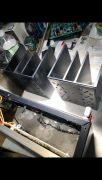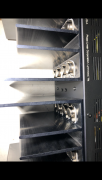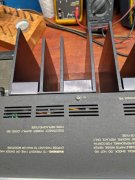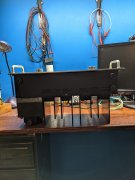Phase Linear 400 Odd Heatsink.
- Thread starter FredR
- Start date
- Joined
- Jan 14, 2011
- Messages
- 74,244
- Location
- Gillette, Wyo.
- Tagline
- Halfbiass...Electron Herder and Backass Woof
- Joined
- Jan 14, 2011
- Messages
- 74,244
- Location
- Gillette, Wyo.
- Tagline
- Halfbiass...Electron Herder and Backass Woof
- Joined
- May 26, 2013
- Messages
- 713
- Location
- St. Louis, MO.
- Tagline
- Born and Raised In The 700 Watt Club.
I have that cast/extruded one on the 400 S2. I much prefer it as the amp can sit stable and level on the transformer and fins, face plate up. Also, the output transistor mounting area is flatter, better contact for heat transfer.
My 400 S1 has that eight fin extra long one made out of bent plate. The fins are so damn long that I need to put a piece of 2x4 under the transformer bell to stand it face plate up. And there's probably a sizable thermal break between the base and those extra fins. Mine never get hot, maybe just a little warm, if I really crank it. I think those giant S1 fins were pure marketing.
My 400 S1 has that eight fin extra long one made out of bent plate. The fins are so damn long that I need to put a piece of 2x4 under the transformer bell to stand it face plate up. And there's probably a sizable thermal break between the base and those extra fins. Mine never get hot, maybe just a little warm, if I really crank it. I think those giant S1 fins were pure marketing.
Attachments
-
2 MB Views: 30
-
2.1 MB Views: 30
Same here on my 400 II. @George S. I noticed you have the protective cover snapped back on the outputs...is that advisable on the WOPLs? I would assume they don’t help with airflow on the cans or is that irrelevant? I left mine off

 .
.



 .
.


Same here on my 400 II. @George S. I noticed you have the protective cover snapped back on the outputs...is that advisable on the WOPLs? I would assume they don’t help with airflow on the cans or is that irrelevant? I left mine off
View attachment 50310 View attachment 50311 . View attachment 50310 View attachment 50311
View attachment 50310 View attachment 50311 . View attachment 50310 View attachment 50311
Also, they are in a biamp configuration using a MiniDsp 2x4 and the system is calibrated using REW software. Big mains and subs, 2 400 WOPLs, active crossover, and REW make for a very efficient system.
is that advisable on the WOPLs?
I don't believe removing the covers will help with heat dissipation. We are talking about heat "conducted" from the transistor die to the heatsink, which is very efficient in aluminum.
You are thinking of "radiation" or radiant heat through the air from the output transistor case to the covers, very inefficient heat transfer.
In fact, the transistor covers add some additional mass and surface area to conduct heat from the heatsink and into the air.
- Joined
- May 14, 2014
- Messages
- 2,289
- Location
- Southwest Kootenays BC
- Tagline
- No such things as bad days, just bad moments
I was home alone yesterday as wife was off taking care of some family business. At approximately 1030 I cued up 52 Ramones albums on Foobar2000 and let them play continuous and LOUD while I did some yard work out back and finished up the Hakko units upstairs. The system was cranked, media room windows were open as it was a warm day in Ohio, working outside the music was loud, upstairs working on the Hakkos the music was loud. The meters were swinging up to 1/4 of travel. Nine hours later after not touching the system I felt the amps for heat.
The fins were slightly above room temp, the output covers were warm, the transformers were warmer, and the top cover plate was the warmest. But nothing was hot.
To improve the cooling, if needed, maybe more holes or slots in the top and bottom plates are required. I can envision a steel mesh with a frame.
Perry recommended a nice fan unit some time ago that sits on top of the amp and blows upward. Rather than more air on the fins, I think cabinet ventilation may work better.
But then, if it's rack mounted, choices are limited.
The fins were slightly above room temp, the output covers were warm, the transformers were warmer, and the top cover plate was the warmest. But nothing was hot.
To improve the cooling, if needed, maybe more holes or slots in the top and bottom plates are required. I can envision a steel mesh with a frame.
Perry recommended a nice fan unit some time ago that sits on top of the amp and blows upward. Rather than more air on the fins, I think cabinet ventilation may work better.
But then, if it's rack mounted, choices are limited.
- Joined
- Nov 1, 2014
- Messages
- 3,249
- Location
- Gaston, SC
- Tagline
- Victim of the record bug since age five
I was home alone yesterday as wife was off taking care of some family business. At approximately 1030 I cued up 52 Ramones albums on Foobar2000 and let them play continuous and LOUD while I did some yard work out back and finished up the Hakko units upstairs. The system was cranked, media room windows were open as it was a warm day in Ohio, working outside the music was loud, upstairs working on the Hakkos the music was loud. The meters were swinging up to 1/4 of travel. Nine hours later after not touching the system I felt the amps for heat.
The fins were slightly above room temp, the output covers were warm, the transformers were warmer, and the top cover plate was the warmest. But nothing was hot.
To improve the cooling, if needed, maybe more holes or slots in the top and bottom plates are required. I can envision a steel mesh with a frame.
Perry recommended a nice fan unit some time ago that sits on top of the amp and blows upward. Rather than more air on the fins, I think cabinet ventilation may work better.
But then, if it's rack mounted, choices are limited.
The fins were slightly above room temp, the output covers were warm, the transformers were warmer, and the top cover plate was the warmest. But nothing was hot.
To improve the cooling, if needed, maybe more holes or slots in the top and bottom plates are required. I can envision a steel mesh with a frame.
Perry recommended a nice fan unit some time ago that sits on top of the amp and blows upward. Rather than more air on the fins, I think cabinet ventilation may work better.
But then, if it's rack mounted, choices are limited.
So far, I haven’t heard anyone on this forum remarking about thermal failure.
I'm going to look at the top and bottom plates and consider drilling ventilation holes. Getting those Budwig feet under those amps has to have helped.
I can stack all the plates and drill right through. Probably screw them onto a scrap board, mark holes in pencil in a grid pattern, center punch, drill, de-burr, done. Another project!
I can stack all the plates and drill right through. Probably screw them onto a scrap board, mark holes in pencil in a grid pattern, center punch, drill, de-burr, done. Another project!
I'm going to look at the top and bottom plates and consider drilling ventilation holes. Getting those Budwig feet under those amps has to have helped.
I can stack all the plates and drill right through. Probably screw them onto a scrap board, mark holes in pencil in a grid pattern, center punch, drill, de-burr, done. Another project!
I can stack all the plates and drill right through. Probably screw them onto a scrap board, mark holes in pencil in a grid pattern, center punch, drill, de-burr, done. Another project!
Or, send me the covers and leave your top and bottom open...




